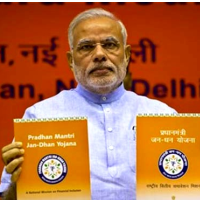Reform 02: Modi Launches Banking for All
 Prime Minister Narendra Modi launches the financial inclusion program (photo: AP)
Prime Minister Narendra Modi launches the financial inclusion program (photo: AP)
The promise that Prime Minister Narendra Modi made in his Independence Day speech two weeks ago was implemented on Thursday as he launched the new Jan Dhan Yojana (People’s Wealth Scheme). This aims to provide a bank account to every family in India, and end what Modi calls 'financial untouchability'.
Only 35 percent of India's 1.2 billion people have bank accounts, according to the World Bank, compared with 56 percent in Brazil and 64 percent in China. Just over a fifth of Indian adults saved any money in 2011, and only half of those kept this in a financial institution.
“Even after 68 years of independence, 68 per cent of the population are not connected with banking,” the Prime Minister said. To eradicate poverty, he said every Indian should be integrated into the economic system.
The ambitious program plans to provide 75 million bank accounts by 2018. Of these, 15 million were opened on the first day itself, which the Prime Minister said is a world record.
Each account holder will receive a 'RuPay' debit card and an accident insurance worth Rs. 1 lakh ($1,667). Those who sign up before January 26, 2015 will receive an additional insurance cover of Rs. 30,000 ($500). Good customers would also be eligible for an overdraft facility of up to Rs. 5,000 ($83) after six months.
The four-year initiative, which is Modi’s brainchild, is expected to help the government save billions of rupees on social spending. It will allow the state to channel welfare and work payments directly into the accounts of individuals rather than through regional and local offices. This is expected to reduce the large-scale corruption in the current system.
The program would also protect needy households, farmers and small-business operators from local moneylenders who charge extortionate interest. National savings would get a boost at a time when India needs investment to fund infrastructure development.
Some critics fear that the overdraft facility may end up swelling bad loans in the banking system as the scheme does not specify how the banks can collect debts.
Earlier this month, Raghuram Rajan, governor of the Reserve Bank of India (RBI), said bank profitability was crucial for the success of the program.
According to the RBI’s annual report, bad loans at banks rose to 4.1 percent of gross advances in March from 2.4 percent in March 2011. Restructured loans also rose to 5.9 percent of gross advances in March from 2.5 percent in June 2011.
Financial inclusion isn't a new approach in India. State-run banks are required to open rural branches and they still have to meet quotas on lending to ‘priority sectors’ like agriculture and small-scale industry.
Yet Modi's program contains a crucial innovation, according to Subir Gokarn, director of research at the Brookings Institution's India office: the government is providing households not merely with a bank account, but also credit and insurance.
That makes a huge difference for a poor person who might have no use for a stand-alone savings account. “It looks tiny, but for this guy, it will be an alternative channel of capital,” Gokarn told The Wall Street Journal. “Now there is some meaning for this guy to have an account.”
To Learn More:
Modi: Banking for all to end "financial untouchability" (by Manoj Kumar, Reuters)
Attempt to End Financial Untouchability, Says PM Narendra Modi About New Scheme (NDTV)
India Launches Program Giving Poor Access to Bank Accounts (by Raymond Zhong, The Wall Street Journal)
- Top Stories
- Controversies
- Where is the Money Going?
- India and the World
- Appointments and Resignations
- Unusual News
- Latest News
- India College Chain’s Expansion into U.S. Draws Opposition from Massachusetts Officials over Quality of Education
- Milk Shortages in India Tied to Release of New Movies Featuring Nation’s Favorite Stars
- Confusion Swirls around Kashmir Newspaper Ban in Wake of Violent Street Protests
- Polio-Free for 5 Years, India Launches Vaccine Drive after Polio Strain Discovery
- New Aviation Policy Could Increase Service, Lower Ticket Prices






Comments